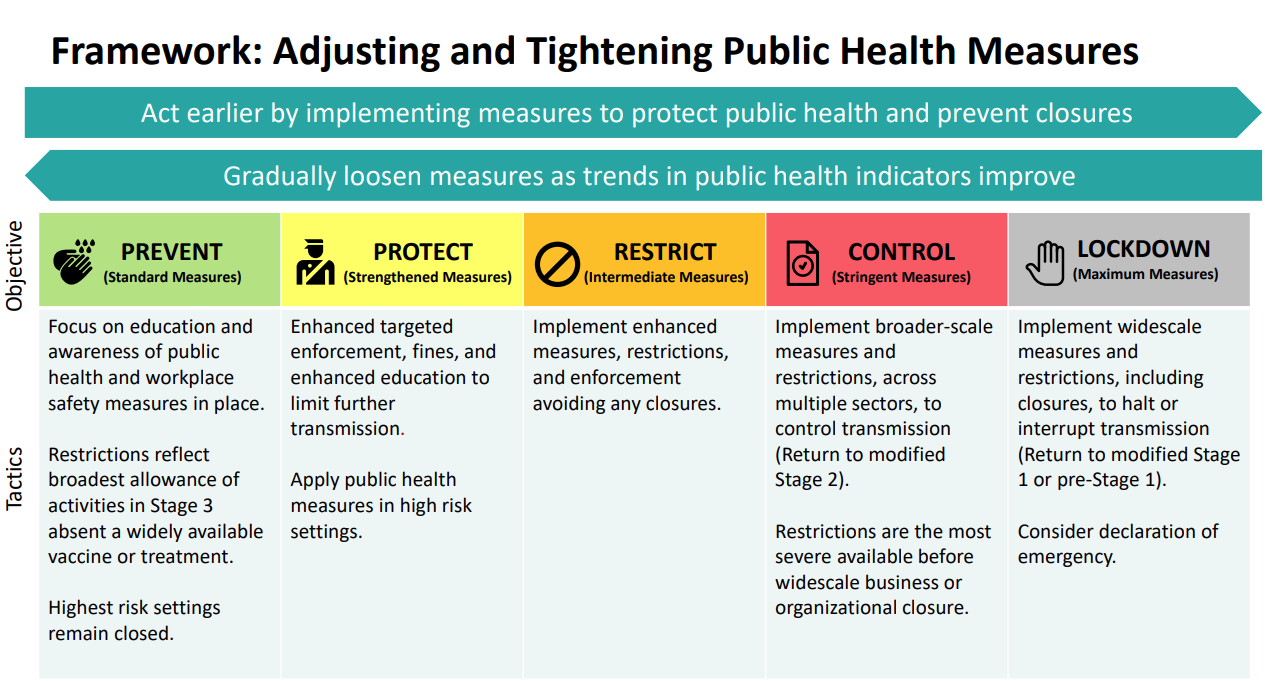GUELPH – Wellington-Dufferin-Guelph Public Health (WDGPH) will likely move from green to yellow in the coming days after officials get a closer look at the new colour-coded COVID-19 framework the province unveiled earlier this week.
The colour system replaces the stage (one, two and three) system – and its recently-added modified categories – that the province had been using to identify COVID-19 hot spots across the province and corresponding restrictions.
The advantage of this new system, officials say, is it allows for clear and consistent criteria on when and why restrictions should be imposed, and when they can be lifted.
Dr. Nicola Mercer, medical officer of health, told the WDGPH board on Nov. 4 that as Premier Doug Ford held up the colour-coded map of the province, “a number of health units were identified as green but do not meet the definition … We anticipate our health unit will move from green to yellow.”
Mercer said the new system considers weekly case counts, positivity rates of tests and transmission rates reported by health units when determining its colour.
In the new plan, green has the fewest restrictions, and they increase gradually through yellow, orange, red, and finally grey, which is full lock-down.
To be considered Green (or “prevent”), a health unit must report fewer than 10 cases per 100,000 people weekly.
As of Nov. 6, WDGPH was reporting a weekly rate of 17.5 cases per 100,000 people.
“The province feels we are yellow,” she said.
There are still many details to figure out with the new system, including whether it will go “sub-regional” or just regional, Mercer said.
After a preliminary look at WDGPH numbers, “Wellington County is definitely green,” Mercer said, but Guelph and Dufferin numbers put the entire region into yellow.
“We don’t have an answer yet. The province will make that determination.”
Mercer said 60 per cent of the cases in the WDGPH region are the result of private social gatherings – not parties with big numbers, but people hosting or attending many smaller gatherings with multiple “bubbles” of people.
Mercer said with the Thanksgiving surge in numbers revealing itself and Christmas in the offing, it’s time to stop thinking there’s safety in bubbles.
“Think about how many people you contact and try and decrease that,” she said.
COVID-19 can be spread via touch surfaces, but it’s really spread by droplets.

The new colour-coded COVID-19 framework introduced by the province on Nov. 3 includes five levels:
Green (prevent), Yellow (protect), Orange (restrict), Red (control); and Grey (lockdown – a measure of last and urgent resort).
The risk of contracting the virus increases the more time we spend with people indoors in close proximity, officials say.
So the best ways to limit the spread remain keeping indoor visits short, maintaining a six-foot distance, and wearing a mask.
Mercer was not quite ready to endorse an announcement earlier in the week by Dr. Theresa Tam, Canada’s Chief Public Health Officer, recommending three-layer non-medical masks.
Mercer said she wasn’t sure exactly what Tam meant.
“I want to see the research,” she said.
What Mercer could confirm, however, is that single-ply masks are not effective, nor are fabric “toques” that pull up from around the neck and the clear mouth shields often seen in restaurants.
“They are not to be worn,” she said. “They offer no protection.”
On flu shots, Mercer said there is enough vaccine for this region despite reports of shortages in other regions.
The shipment recently arrived and is being distributed to doctors’ offices, pharmacies and public health clinics.
“It could take a few weeks to get an appointment, but the vaccine is available,” she said.




